Improved data quality using variable Q1 window widths in SWATH acquisition
Data independent acquisition (DIA) on SCIEX ZenoTOF, TripleTOF and X-Series QTOF systems
Abstract
The SWATH acquisition data independent acquisition strategy provides a comprehensive quantitative analysis of complex samples, providing full scan high resolution MS and MS/MS on all detectable compounds eluting off the column. These datasets can then be re-interrogated over and over again as new information on new compounds of interest emerges. Specificity can be optimized by balancing the Q1 window width, the number of Q1 windows and accumulation time per window, such that analyte S/N can be improved significantly while maintaining good quality quantitative results. Optimization to scale the window size with precursor density, based on the matrix being analyzed, can further improve results.
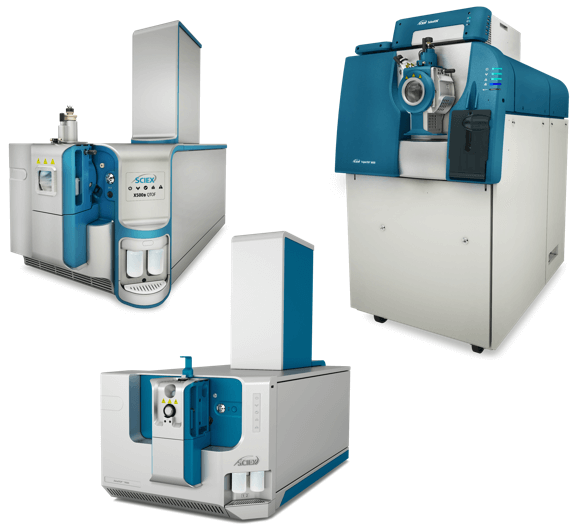
Introduction
In many of today’s mass spectrometry based workflows, the goal is to both identify and quantify a broad range of compounds in complex matrices. Whether it is quantifying differences in proteins or metabolites between complex biological samples, or screening for pesticides from a food matrix, the extreme complexity and dynamic range found in these matrices challenges traditional data dependent workflows to reproducibly and deeply interrogate the sample.
There has been a resurgence in the use of data independent acquisition (DIA) strategies to increase the reproducibility and comprehensiveness of data collection, enabled by recent technological innovations in both MS hardware and software. This acquisition strategy can now be routinely applied to complex sample matrices to collect high quality quantitative data. The most widely used of these techniques is SWATH acquisition on the SCIEX ZenoTOF, TripleTOF or QTOF systems1,2.
In SWATH acquisition, Q1 isolation windows are stepped across the mass range in an LC timescale, transmitting populations of analytes for fragmentation, and high resolution composite MS/MS spectra are acquired at each step. The complexity of the MS/MS spectra and the resulting specificity depends on the number of analytes eluting off the column at the same time within the same m/z isolation window. The more narrow the Q1 isolation window, the better the signal/noise will be in the resulting data, but this must be balanced by how large a mass range needs to be interrogated (Figure 1).
The variable window SWATH acquisition strategy provides an elegant solution to this, by allowing the user to vary the size of the Q1 isolation window based on the density of analyte precursor masses (Figure 2). In this way, an optimal method can be easily built with a broad mass range for analyte coverage and with Q1 isolation windows for best specificity.
Figure 1. Investigating Q1 window sizes for SWATH acquisition. When performing SWATH acquisition, the Q1 isolation windows are stepped across the mass range, and high resolution MS/MS is acquired for a specific accumulation time at each step. When optimizing a method for a SWATH acquisition experiment, one must optimize the Q1 window size, accumulation time and cycle time to strike a balance between sensitivity and specificity.
Key advantages of variable window SWATH acquisition
- Data independent acquisition using the SCIEX ZenoTOF, TripleTOF or QTOF systems using SWATH acquisition
- High sensitivity, resolution and speed of MS/MS acquisition allows a large number of Q1 isolation windows with no loss in sensitivity or reproducibility
- Up to 100 Q1 windows per cycle on TripleTOF 5600+ System, with upper mass limit 1250m/z
- Up to 200 Q1 windows per cycle on the ZenoTOF, TripleTOF 6600+ and 6600 systems and X500 series instruments, with upper mass limit of 2250m/z
- Narrower Q1 isolation windows provide improved data quality through increased specificity
- SWATH Variable Window Calculator3 can be used to optimize the Q1 isolation window pattern for the matrix of interest, to achieve the right balance of analyte coverage and specificity
- Variable Window SWATH acquisition methods are easily built within the Analyst® TF software or SCIEX OS software.
Narrower isolation windows provide increased specificity
While many low level analyte detections in the SWATH acquisition data are good, some will have interferences in some of their MS/MS spectra and therefore their fragment ion XICs. In many cases, tighter Q1 windows can provide improved specificity by reducing the interferences from co-eluting analytes that have a similar m/z and produce similar mass fragment ions. An example of this improved signal/noise is shown in Figure 3 for a peptide from a low abundant protein in a complex digested proteome sample.
As elements of the scoring depend on the consistency of spectral and/or chromatographic profiles of the fragments relative to a spectral ion library, it is clear how reduction of interferences can improve confident detection. It is often observed that significant gains in numbers of analytes quantified is achieved as the number of Q1 windows increases and window size decreases4. And of course, improved peak fidelity will greatly improve the consistency of peak integration and therefore quantitation quality.
Figure 2. Investigating variable Q1 window widths for SWATH acquisition. To achieve better specificity in complex matrices, smaller Q1 windows are desirable especially in the m/z dense regions where many analyte precursors are found. The m/z density histograms constructed from the TOF MS data for the sample of interest (blue line) can be used to a construct variable sized window pattern (red line) using the SWATH Variable Window Calcluator.3 The goal is to equalize the density of precursors in each of the isolation windows across the m/z range. Top shows a typical m/z distribution and Q1 window pattern used for digested proteome samples and the bottom shows a typical m/z distribution for small molecules from a crashed plasma sample.
Figure 3. Decreasing the size of the Q1 isolation windows in SWATH acquisition improves specificity. In this example, the same sample was analyzed twice on a TripleTOF 6600 system, once with a SWATH acquisition method using 25Da wide fixed windows (top, 75 msec accumulation time) and once with a variable window SWATH acquisition method using 100 windows (bottom, 25 msec accumulation time). The signal/noise of the detected peptide peak group is greatly improved due to the much smaller window size used in the variable window method.
Easy to create
The variable window SWATH acquisition method should be built based on the m/z distribution of analytes in the matrix of interest, therefore a single SWATH acquisition method can be built once and then used for that matrix over and over again, no matter what analytes are under investigation. The SWATH Variable Window Calculator3 can be used to compute the best Q1 window pattern for the matrix from the TOF MS m/z distribution of precursors. Then this information can be added to the method building software in Analyst TF software or SCIEX OS software to quickly build a final SWATH acquisition method (Figure 4).
Figure 4. Build a variable window SWATH acquisition method in three easy steps. Any window strategy can be constructed in text file format and loaded into the SWATH acquisition method editor for automatic method building. 1) A text file describing the Q1 isolation window strategy can be constructed using the SWATH Variable Window Calculator3 (which adjusts the Q1 window width based on precursor density). The first two columns describe the start and stop mass of each Q1 window. 2) Load this Q1 window information into SWATH acquisition method editor and adjust the MS and MS/MS settings. 3) An optimized SWATH acquisition method for the matrix of interest is saved.
Conclusions
The SWATH acquisition data independent acquisition strategy provides a comprehensive quantitative analysis of complex samples, providing full scan high resolution MS and MS/MS on all detectable compounds eluting off the column. These datasets can then be re-interrogated over and over again for compounds as new information emerges.
- SWATH acquisition can be optimized by balancing Q1 window width, the number of Q1 windows and accumulation time per window
- Increases depth of quantitative coverage without compromising reproducibility due to improved S/N
- Optimizing window width based on m/z density provides further enhancement of specificity and data quality.
- Allows for increased mass range to be covered
- SWATH Variable Window Calculator3 can be used to compute the window distribution for the complex sample of interest.
References
- SWATH acquisition. SCIEX product page.
- Gillet LC et al. (2012) Mol. Cell. Prot. 11(6), 1-17.
- Download the SWATH Variable Window Calculator - Excel tool.
- Evolution of SWATH acquisition provides large gains in quantified proteins, SCIEX technical note RUO-MKT-02-5772-A.
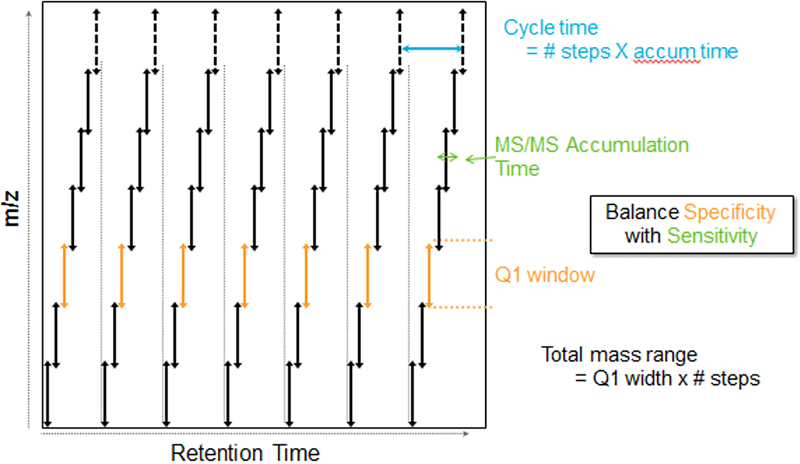 Click to enlarge
Click to enlarge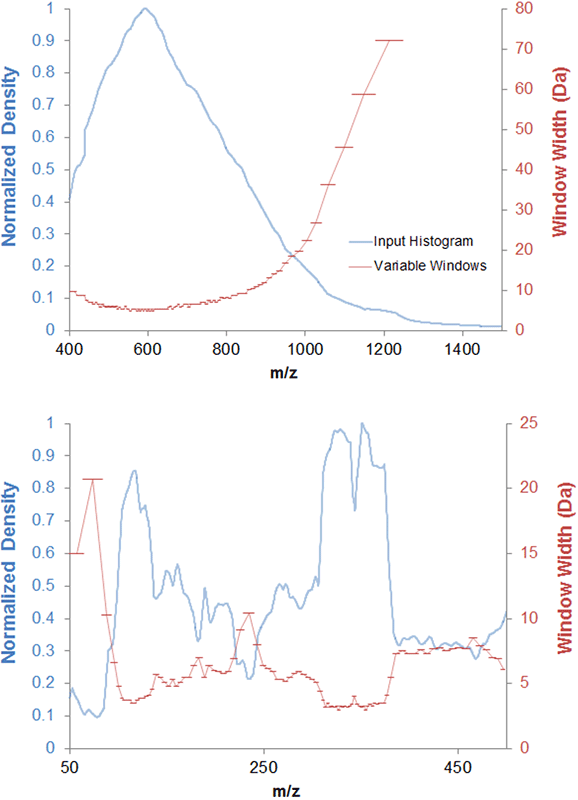 Click to enlarge
Click to enlarge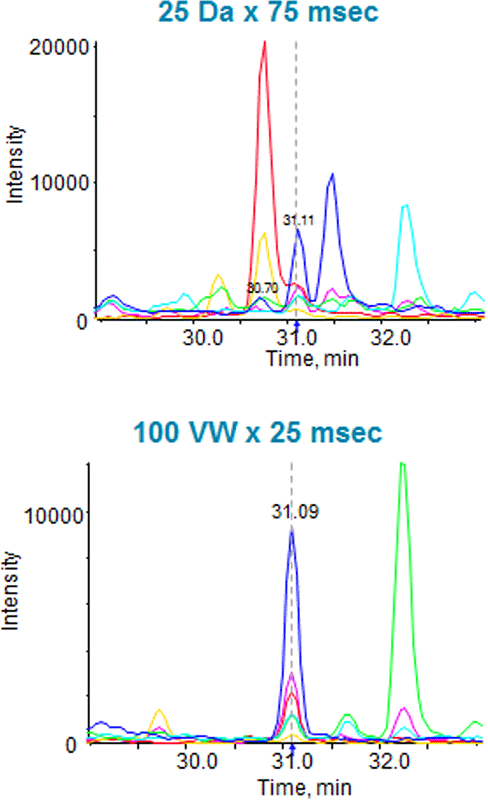 Click to enlarge
Click to enlarge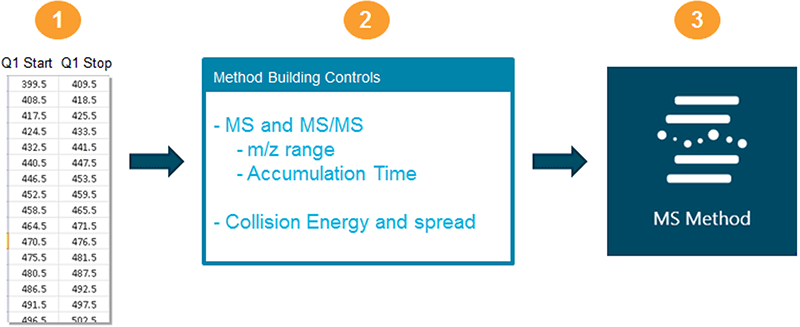 Click to enlarge
Click to enlarge